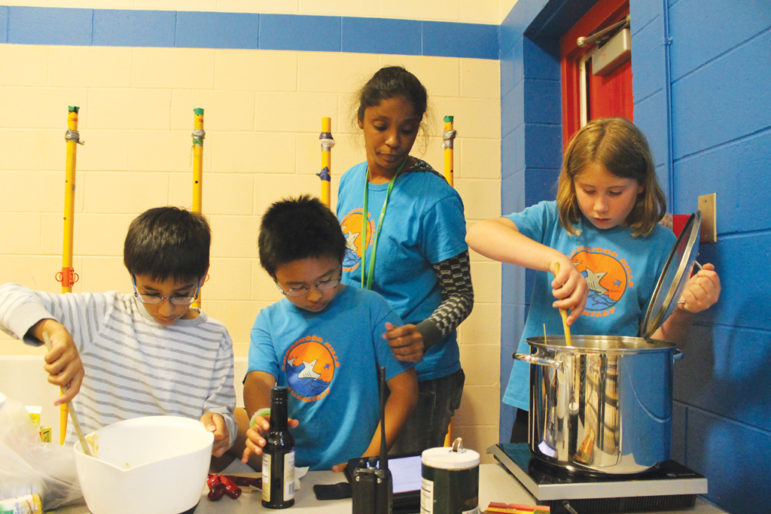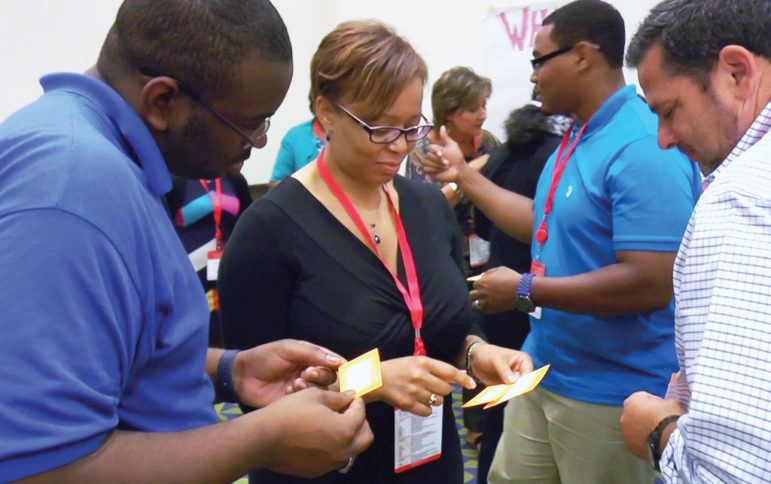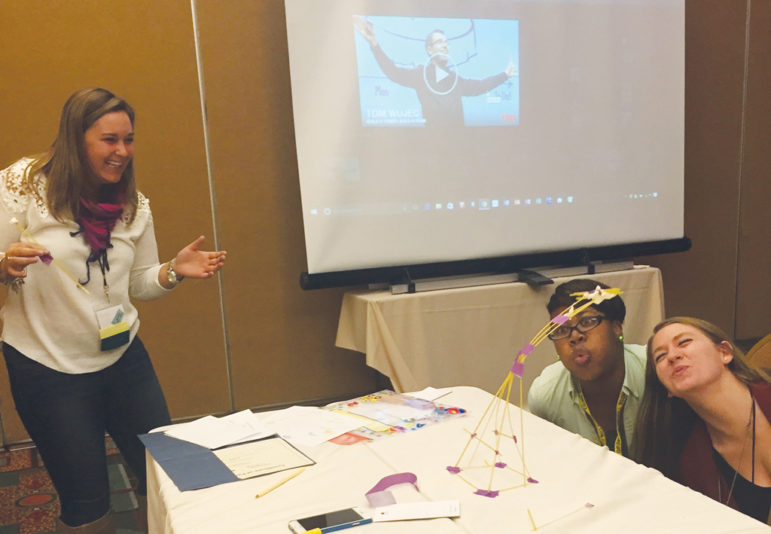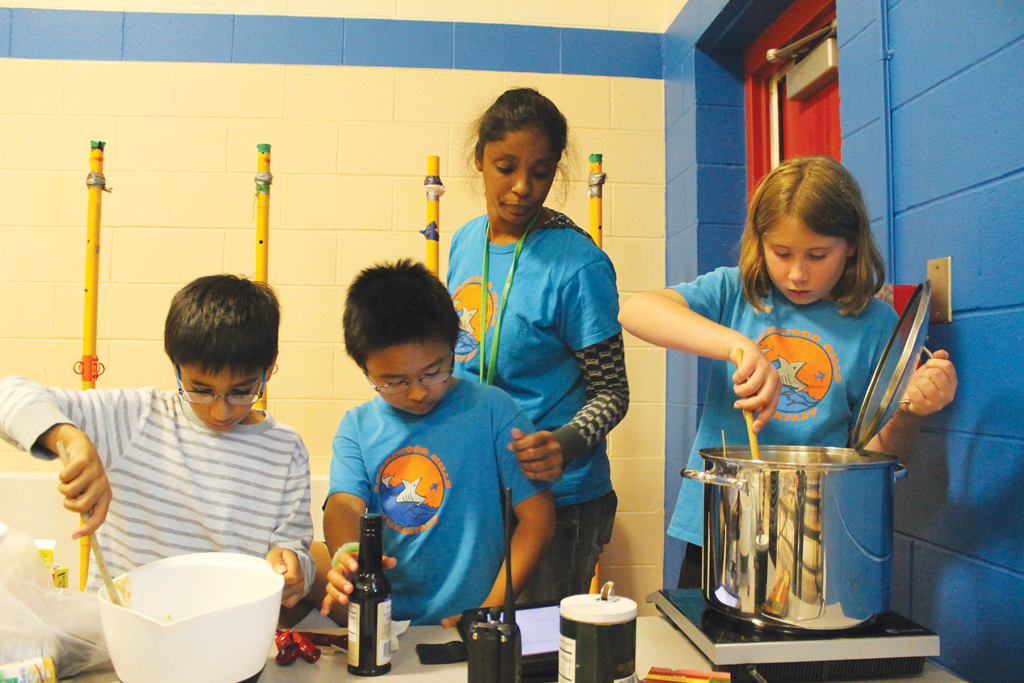
Photo by Julie Monahan, Wisconsin Youth Company
On the first Monday of each month, Wisconsin Youth Company Shorewood AFTER SCHOOL highlights its diverse students by cooking a cultural dish.
What if a tool existed to make your after-school or summer youth program better? Would you get it and read the instructions?
Leaders of statewide after-school networks and many out-of-school-time organizations believe such a tool is available — and they want after-school providers to use it.
Two summers ago, Katie Brackenridge took part in the Summer Matters campaign in California. In an effort to strengthen summer learning programs, she taught providers how to use the state’s quality standards for expanded learning, now a requirement for state funding in California.
At the outset, managers and front-line staff were not enthusiastic. “They’re already working 100 percent,” Brackenridge said. They felt like this was “another mandate,” she said, and they didn’t see how the training would help.
Brackenridge is vice president of programs for the Partnership for Children and Youth, a nonprofit devoted to expanding education and opportunity for young people in California.
As part of the training she offered, trainers sat in on summer program activities with youth. In one instance, a trainer — using the rubric of the quality assessment tool — noted that a staff member was very good at communicating the point of the activity to kids. The observer also noted that the staff member might be able to engage the kids more by letting them explain part of the lesson or having them debrief the group at the end.
Suddenly, front-line staff saw the usefulness of quality standards, Brackenridge said. The quality improvement process communicated specific things they could do.
“Folks were resistant to the process until they saw how it could help them concretely improve their practice,” she said.
What is quality?
Quality standards are the foundation for a quality improvement tool. Standards are usually a list of seven to 12 major areas.
For example, California’s 12 core areas are:
- Safe and supportive environment
- Active and engaged learning
- Skill building
- Youth voice and leadership
- Healthy choices and behaviors
- Diversity, access and equity
- Quality staff
Clear vision, mission and purpose
Collaborative partnerships
Continuous quality improvement
Program management - Sustainability
Each core area is then broken down into components. An assessment tool or series of questions is used to examine each area of a program.
After-school networks in 38 states have developed or are in the process of developing quality standards, according to the American Institutes for Research, a Washington, District of Columbia-based nonprofit focusing on social science research and evaluation. Some of the networks have also gone on to develop a credentialing system for after-school program staff. Some have also adopted a rating system for after-school programs, assigning stars or numbers to inform the public of the quality of the program.
“Quality standards define what quality looks like,” said Heidi Ham, vice president of programs and strategy for the National Afterschool Association. They’re based on research about what makes an effective program and the elements that result in positive outcomes for kids.
“Research shows they get outcomes,” Ham said.
High-quality programs can help reduce the achievement gap between low-income and more affluent students, according to the National Afterschool Association. Such programs show promise for improving high school graduation rates and the rate of enrollment in postsecondary education, according to the association.
“We’re working to move the idea away from any program is better than no program,” Ham said.
A set of quality standards helps in program planning and professional development, Ham added, and provide a common language for working with school partners and government officials. Funders want to see them in a program, too, she said.
Brackenridge said if you start doing quality improvement, you’re likely to see funding as a result.
California and New York are two states that require after-school providers to be involved in a quality improvement process as a condition of receiving state funding.

Photo by Roger Newton
Youth development professionals participate in professional development trainings on the state quality standards at the 2016 Georgia Statewide Afterschool & Youth Development Conference this fall. Here they are focusing on youth feedback and other forms of program evaluation.
Confusion about choices
But which standards should a youth-serving organization adopt? A city may have a set of standards for child care or after-school programs, a state may have another set and a funder may want a third.
Ashley Rose is the after-school lead program manager for Wisconsin Youth Company, a Madison, Wisconsin-based nonprofit that serves more than 1,000 kids in 27 after-school programs in Dane and Waukesha counties.
Wisconsin Youth Company was started 40 years ago to provide after-school care as more women moved into the workforce. Early on, it gained accreditation from the city of Madison, which was a pioneer in setting standards and accrediting child care providers.
The Wisconsin Youth Company also has a summer program that is accredited through the American Camp Association.
Several years ago, the Wisconsin Department of Children and Families began a state quality rating system called YoungStar. Wisconsin Youth Company chose to take part because of the organization’s commitment to quality, Rose said. Participation in the rating system was also a requirement for state funding through a program known as Wisconsin Shares.
As a result, the organization participates in several different systems designed to ensure quality.
“Many of the standards are very similar, which is helpful,” Rose said. But new young staff members at the organization are startled.
“For staff who are just beginning, it does seem quite confusing sometimes,” she said. Dealing with three different agencies can seem overwhelming to them, she said.
Wisconsin Youth Company sees its adherence to various quality systems as a strength of the organization. But other youth-serving organizations may feel buffeted.
“It can be troubling when programs are asked to respond to quality standards from different stakeholders. That is a challenge for organizations across the country,” Brackenridge said.
Many city and state standards contain a lot of similar elements, however, she said.
“I would encourage providers to look at their goals and their vision statement and then look at existing quality standards” and see where they align, Brackenridge said.
Ham has a list of questions an organization can ask to determine
which quality standards to adopt.
‘Fewer fires to put out’ by using standards
Adopting standards, assessing your program and then setting up an improvement process may seem daunting, Ham said. Providers may be concerned they don’t understand the whole continuous improvement process, and they may wonder how to fund it, Ham said. The other big issue is time, she said.
“You just need to start where you are and go from there,” she said, rather than expecting to address all the standards at once.
Use the assessment tool to figure out where you are and make an action plan, she advised.
Definitely don’t address all the standards, Brackenridge advised. Pick three, she said.
New York was one of the first states to set up quality standards and develop an assessment tool. Allie Lidie, the associate executive director of the New York State Network for Youth Success, said providers often feel like they don’t have time to implement quality standards “because they’re always putting out fires.” But if you go through the quality improvement process, there will be fewer fires to put out, she said. You’ll end up bringing in additional stakeholders who can be very helpful. You’ll have improved communication and a more informed staff, for example, she said.
“If you put in the time now, you’ll get to a point where it’s much easier,” Lidie said.
The starting point is up to the organization, she said. Pick the element you want to work on at first. Pick an area you’re strong in if you want to encourage your staff and learn the steps of the process, she said. Or if you have a strong need for improvement in an area, start with that, she said.
It’s not a set process, she said. “It’s flexible.”
What it important is to schedule quality improvement, she said. Embed it in your program, Lidie said. When you have a staff meeting or a board meeting, include quality improvement on the agenda. It should be an item in reports to parents or the community, she said.
Brackenridge calls the quality improvement process “a mindset.”
“I see this as an essential part of youth programming, not an extra,” she said. “We want to do good work. That’s why we enter this field.”
“This is a process that helps you do that,” she said.

Photo courtesy of the New York State Afterschool Network
Participants at the 2016 New York State Network for Youth Success annual conference, held in Rochester, New York, use the marshmallow challenge as an interactive training activity focusing on quality program standards.
How to pick the right quality standards for your organization
Heidi Ham, vice president of programs and strategy for the National Afterschool Association, recommends asking the following when beginning to consider quality standards:
- What quality standards (if any) are required by our state, our organization, our funders and/or other supporting entities?
- What is our goal, what are we trying to accomplish by adopting quality standards? What do we see as the benefits of adopting quality standards?
- What quality standards are available?
Ham recommends evaluating a particular set of standards by asking:
- How does this set of quality standards support our goals?
- How might we integrate the quality standards into our system? What tools, resources and professional development are available along with the standards?
- What is the direct cost? What are the potential indirect costs?
- Are the standards research-based and designed by a reputable organization?
- What ultimately would be best for us and the community?
Resources
- “High-Impact Afterschool for All: A Statewide Quality Framework,” Afterschool Matters journal
- “Measuring Program Quality: A Guide to Assessment Tools, Second Edition,” Forum for Youth Investment
- National Afterschool Association issue briefs on program quality (naaweb.org)
Find your state after-school network at statewideafterschoolnetworks.net/.
New York state an early pioneer
In 2010 the New York State Afterschool Network developed its own standards as well as a method of assessing them. Called the Quality Standards and Assessment Tool (networkforyouthsuccess.org/qsa/) it has served as a model for other states and is widely used in New York. Unlike other standards, it calls for a method of self-study that focuses on continued improvement. An online user’s guide leads users through the steps of assessing their program. It provides ways that programs can improve themselves immediately and in the future.






























